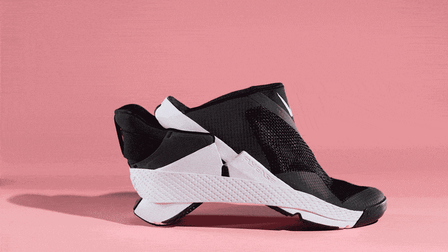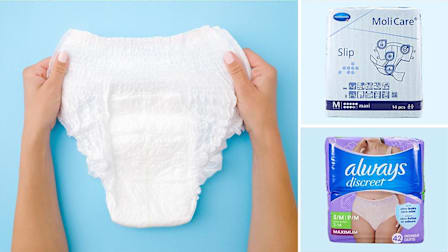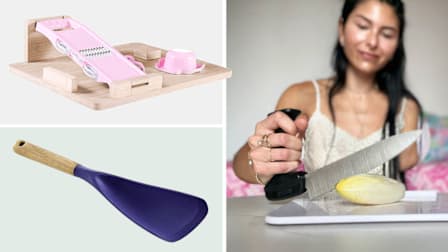Clever Hacks to Maintain Independence With Vision Loss or Blindness
Blind writer and podcaster Maxwell Ivey shares his tips for navigating daily life
When you shop through retailer links on our site, we may earn affiliate commissions. 100% of the fees we collect are used to support our nonprofit mission. Learn more.
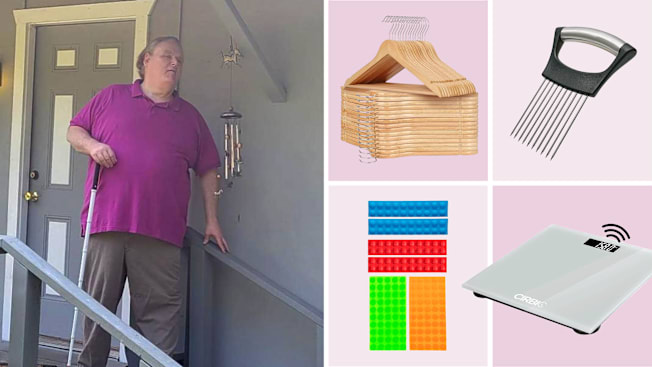
At first, I had perfect vision, but around age 5, things began to change.
A rare disorder called retinitis pigmentosa (RP) began causing progressive damage to my retinas, and throughout elementary school, I went from being able to read a regular print book in a dark room to needing more light, to thicker and thicker glasses, to using magnifiers, and eventually to using a closed-circuit TV system that would magnify a book on a screen.
Getting Dressed
Having recent vision loss doesn’t mean you are limited to sweats or jeans and T-shirts. There are many stylish people living with vision loss. Here are some of the methods they use for organizing clothes.
To keep matching clothes or parts of an outfit together, you can tie a string around the hangers or group them together with a scarf or a necktie. Or, like I do, you can put the outfit all on one hanger: pants, then shirt, then jacket. You need heavy hangers for this method, preferably wooden ones.

Photos: Getty Images, Amazon Photos: Getty Images, Amazon
For organizing your closet by color, you can use straight pins or safety pins. Make your own “key,” associating each color with a certain number of pins or a particular placement or direction of the pins.
You can also find braille laundry tags. Braille is not something people are going to learn overnight, but the tags are very simple, with just two or three characters per tag. You could even think of them as a first step in learning braille.
For keeping your socks straight, there are sock clips or sock rings. While these products are very popular in the blind community, they have also been widely adopted by the general population—because everyone loses socks in the wash.
Finally, there’s an app called WayAround. It allows you to record a description on a small plastic disc, and you can tap the disc with your smartphone to have the description read aloud to you. Then you can have the discs sewn into your clothes and easily identify each piece.
Pro tip: Consider having a conversation with your dry cleaner about getting their help in maintaining your system.
Health and Hygiene
Since many older people have health conditions before dealing with vision loss, I wanted to mention some devices that can be useful. There are talking scales, thermometers, and blood pressure cuffs.
You can purchase plain plastic weekly pill organizers and fill them for a parent, or you can explore higher-tech solutions like the Hero smart dispenser, which dispenses pills automatically and allows caregivers to keep an eye on medication adherence.
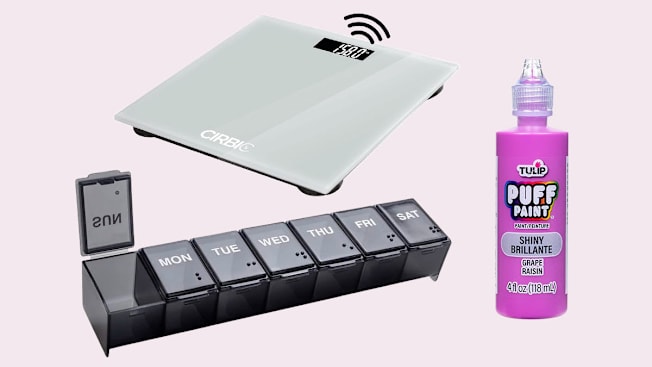
Photos: Amazon Photos: Amazon
Look into pill dispensers that allow you to set up voice reminders or alarms. There is also ScripTalk, a service that can be adopted by pharmacies and allows users to listen to all the information that appears in small print on the side of the bottle. Radio frequency identification (RFID) labels are attached to your pill bottle by the pharmacy, then you can tap your phone against the label or set the pill bottle on the ScripTalk Station to have the medication and dosage information read aloud.
When it comes to identifying shampoo, conditioner, body wash, and other bottled products, I find that tape works really well. To tell the bottles apart, you can use different kinds of tape with varying textures, or you can use a different number of strips of tape on each bottle. This solution also works for cosmetics.
If there are too many jars and bottles to keep track of using tape, I recommend using puffy paint. You can paint shapes (or squiggles or dots) distinct to each item. The paint hardens when it dries.
To help maintain good dental health, I use dental picks. Not toothpicks, but dental floss picks that are easier to use than string floss. You could also consider a water flosser.
Finally, for men: Going to the bathroom can be challenging. After surgery for a knee injury in college, I was given a plastic urinal to use until I could get back on my feet. It worked so well that I have used one ever since. I can’t tell you how much it has improved my confidence in the bathroom.
For doing laundry, I recommend puffy paint again as a way to mark machine controls and bottles of detergent and fabric softener. At my house, we even have puffy paint on the breakers in our breaker box—also a tip for anyone who might need to navigate that in the dark.
Preparing Food
Many visually impaired people enjoy cooking. I’m not one of them. I’m happy as long as I can navigate my microwave. And when I’ve traveled and stayed in an Airbnb, I’ve learned to work with unfamiliar microwaves. I use tape to mark the “reset” button and the “popcorn” button (on machines that still have one), because that’s usually the one with the highest heat. Once it’s going, you can set a timer on a talking clock or timer.
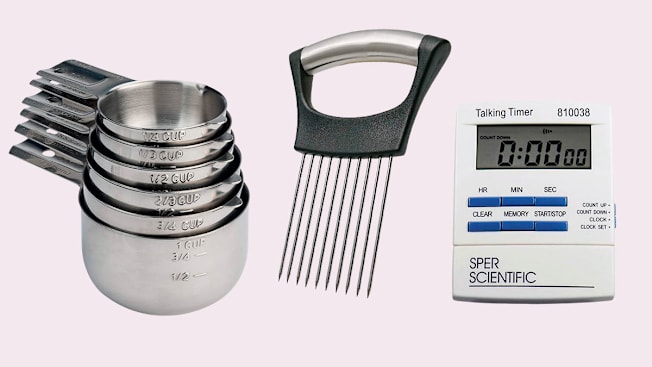
Photos: Amazon Photos: Amazon
But for some people, it’s important to be able to continue really cooking—beyond using the microwave—after vision loss. For those, there are measuring cups and spoons with tactile labels; it can take time to get used to pouring with vision loss—be patient with yourself. For spices, again, puffy paint works really well.
When it’s time to slice or dice, there are cutting guides forsafe chopping. And there’s even a new knife called the Nulu Knife, designed to be both safer for disabled people and easier on older hands.
Getting Around at Home
There is a long walk over uneven ground to reach our mailbox. I had a certified orientation and mobility specialist help me find landmarks that allow me to walk it safely. But I have a friend in a similar situation who wanted to be able to walk to and from a boat dock on his property. He had wooden posts driven into the ground and tied a rope from one to the next. This way, he can just follow the rope to and from his back door.
Our home is over 50 years old and was built on piers a few feet above ground level. We have a ramp on one side and steps on the other.
To remind myself which side of the porch is which, I placed a jester’s hat on the exterior wall of the house between the front door and the ramp, and I hung a set of wind chimes on the other side of the door, going toward the steps. This simple solution gives me variety, fun, and a safe way to enter and exit the porch. Accessibility doesn’t have to be sterile and boring.
TV and Radio
Although I try to avoid high-tech options, we can’t totally avoid technology at this time in history, and TVs represent a popular pastime, even for those of us with vision loss.
Many modern smart TVs and streaming devices offer accessibility features, such as onscreen narration. In my experience with this feature, the voices aren’t the best quality, but they can help you or your loved one navigate the screen.
If you don’t mind a little tech, you can also consider using Alexa or Google Assistant. The smart assistants have some capabilities that may help you avoid the screen reader learning curve.
For example, I am a big-time sports fan. I have a SiriusXM subscription just to listen to the hometown broadcasts of sports events, and one of the best things I’ve ever done was to connect it with my Alexa, using its SiriusXM skill. I can now tell Alexa to play the Texans, Astros, or Rockets on Sirius, and she will. No screen reading required.
Playing Games
Though many people with disabilities find themselves struggling to accomplish mundane daily tasks, we all need to be able to relax and play. Many games rely heavily on vision, but there are some ways around that.
You can get braille playing cards, but learning enough braille to use them can take a while. Large-print playing cards are easier to come by and are a more convenient option for those who have enough vision to use them.
There are quite a few board games for those with low vision and blindness, but most rely on braille. I again suggest keeping it simple with tactile board games like checkers, chess, backgammon, Othello, or Connect Four. Othello was always my favorite because it was ultra-portable, and the small play space makes it easier to adjust to thinking strategically with tactile information.
Books and News Stories
Not much can beat a good book. I can recall the experience of losing my vision most clearly by remembering how it affected my ability to indulge my love of reading.
I started reading actual books at an early age, and I was heartbroken when I could no longer read the printed word for myself. I missed trips to the library, book stores, and the book fair at the end of the school year. But I didn’t have to give up on books completely.
The U.S. and many developed countries have libraries for the blind where you can borrow audiobooks. Many people download audiobooks from the National Library Service for the Blind and Print Disabled straight to their phones. However, for those who prefer not to rely on a phone, the library also continues to send out digital books and magazines on plastic cartridges that can be played on a simple digital player.
Also, the National Federation of the Blind operates a program called NFB-Newsline, which offers news stories read to you over the phone for free. You can even access this service through a smartphone app or an Alexa device. It’s an incredible service for those who can navigate the dial pad on a phone.
Dial pads and touchscreens are great places to use bump dots. They are little raised dots that you peel and stick on surfaces to help with navigation. You may have seen them on a typewriter keyboard.
Don't Give Up
While I’ve covered a wide range of ideas for adapting to vision loss in this article, new solutions are being discovered and created every day. The only solutions that will matter to you are those that work for you and address your specific needs. Don’t be afraid to keep exploring new approaches, asking new people, and trying new products. Don’t give up on the things, people, and activities that bring you joy.
The next thing you try might be the one that works.


















